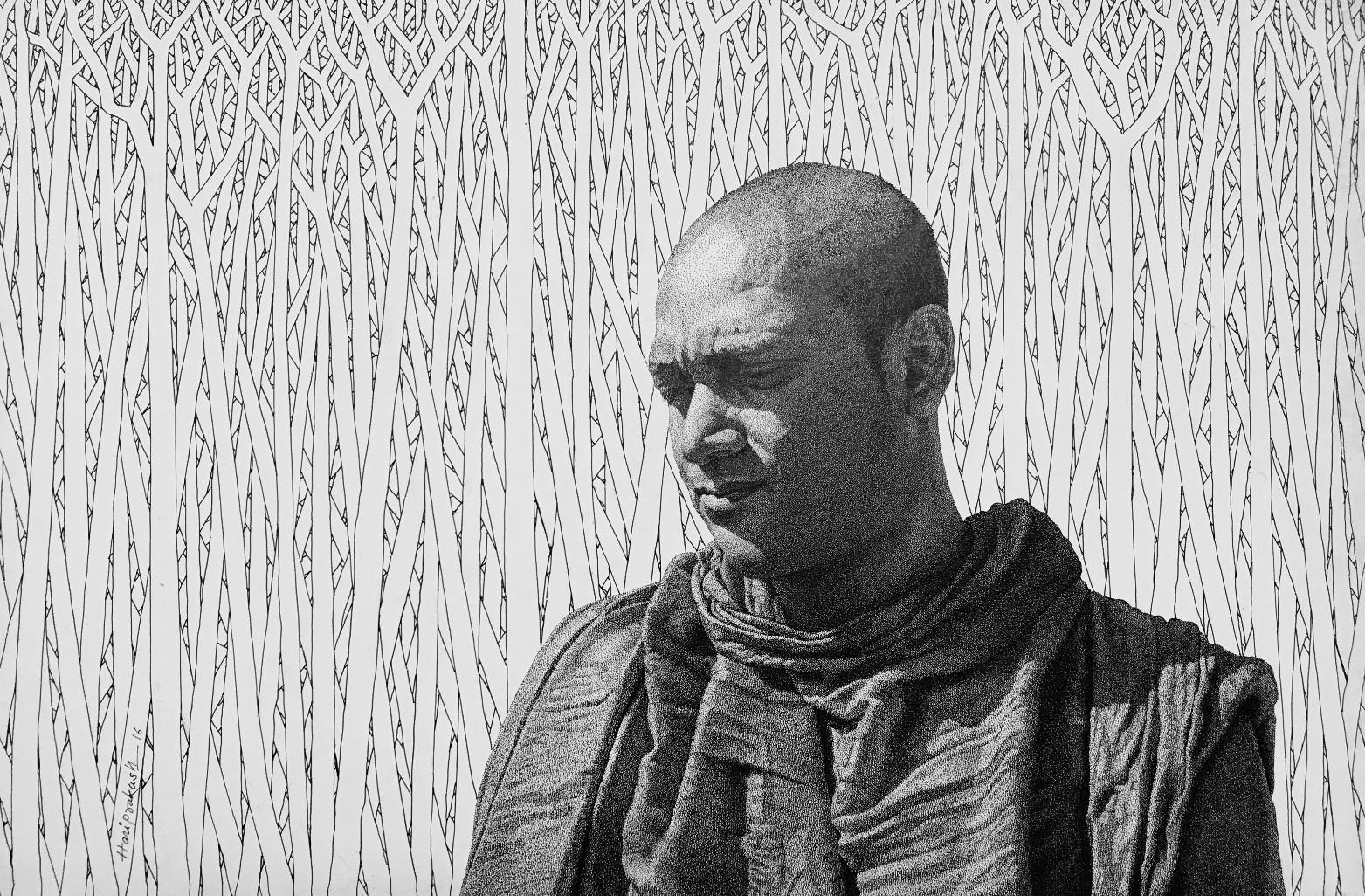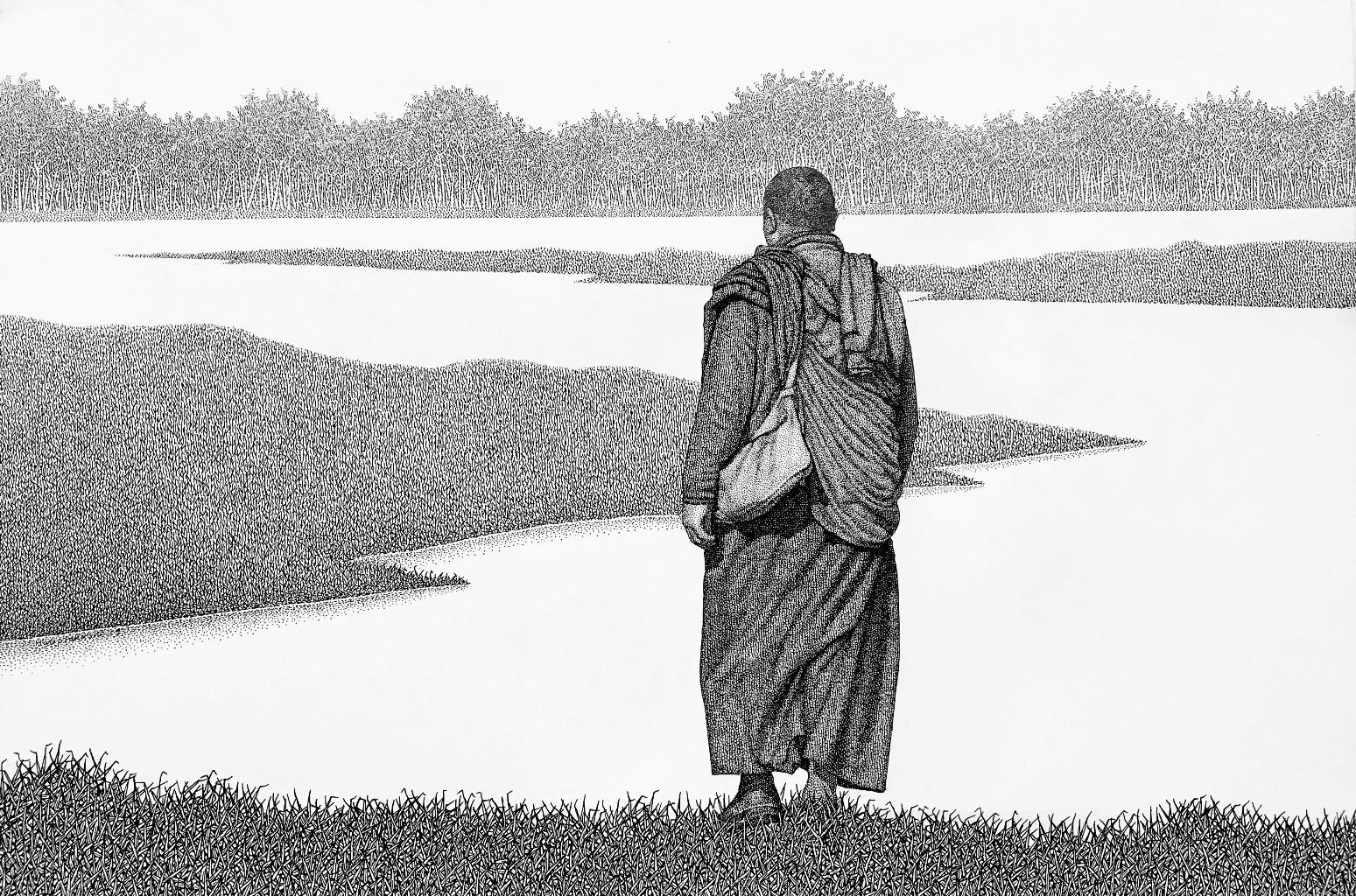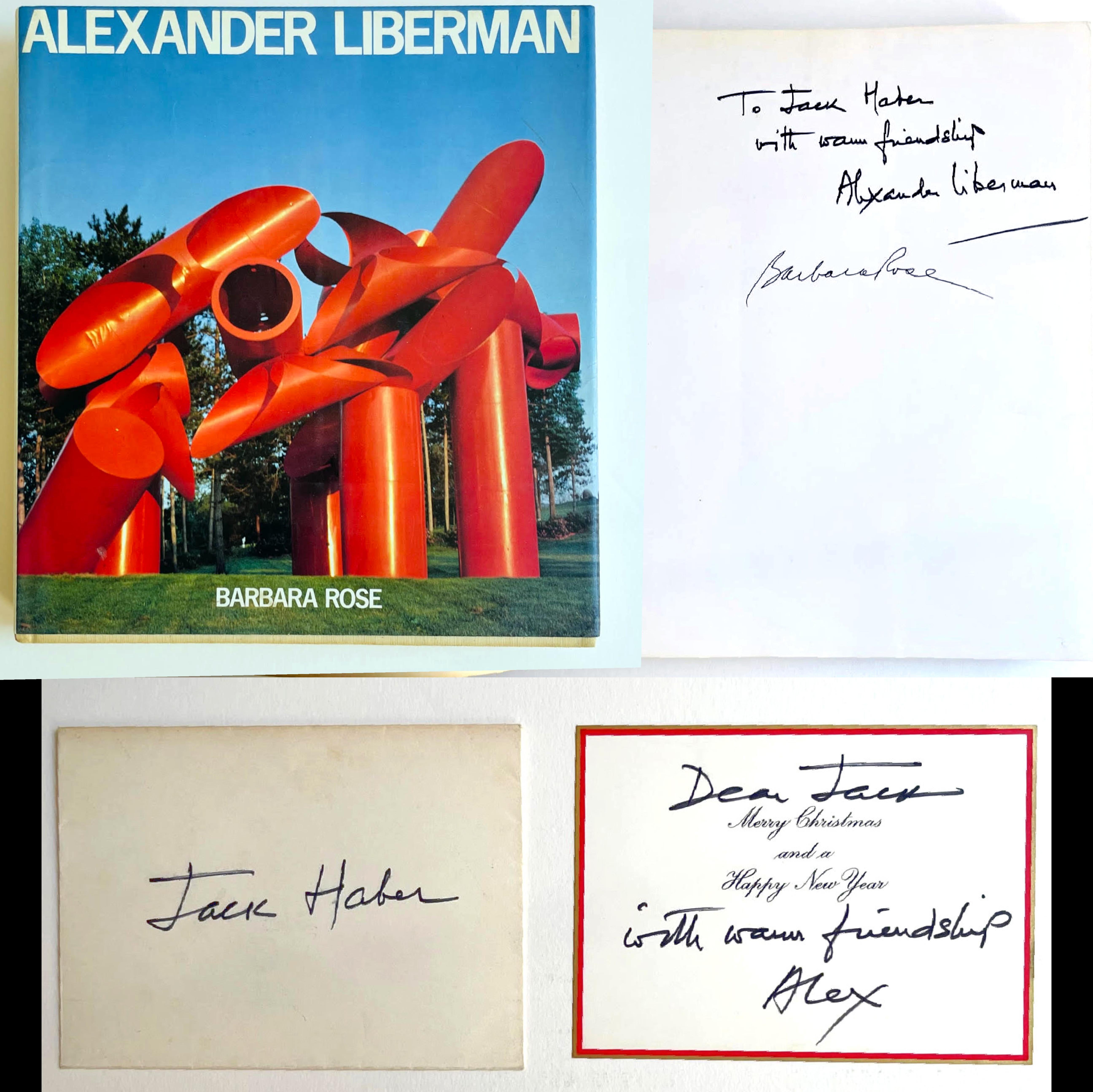Items Similar to Map of Palestine or Judea, Illustrating the History of the New Testament
Want more images or videos?
Request additional images or videos from the seller
1 of 2
Rev. Nathan B. RogersMap of Palestine or Judea, Illustrating the History of the New Testament1843
1843
About the Item
Pen and ink on paper, laid down on canvas, mounted to wooden scroll bars
Signed and dated lower right: “Drawn by N. B. Rogers August. 1843”
Inscribed with an ownership inscription on the verso: Rev. E. D. Daniels, Palmer, Mass.
Provenance:
Rev. Eugene Davidson Daniels, Palmer, Massachusetts, 1871
This extraordinary manuscript map is a rare survivor of the devotional and educational culture of New England in the first half of the nineteenth century. Although at first glance resembling a large-scale engraving or printed publication, this precisely rendered wall map was entirely drawn by hand, the product of meticulous research by a minister working in isolation in rural Maine. The map shows New Testament era cities, towns, tribal areas, and political borders as well as physical features such as rivers, lakes, mountains, and hills (indicated by half-tone cross-hatching). On to this geographically accurate rendering of the Holy Land, Rogers has located and inscribed significant locales mentioned in the Gospels and has annotated these places with relevant citations from the Bible. He further records these by plotting the travels of Jesus on what resemble a series of trails across the Holy Land. Each is distinguished by a different pattern of dots and dashes – correlated to an explanatory table at the lower right. From this we know that these lines document the “Flight into Egypt and return,” “Travels of Christ from Nazareth to Jerusalem and return,” “Travels from the commencement of his Ministry to the first Passover,” “Travels from the first and the second Passover,” “Travels from Jerusalem to Galilee after the 2nd Passover,” and “Travels from the third Passover to the Crucifixion.”
An inset map of “Jerusalem and its Environs” appears at the upper left, again meticulously inscribed with buildings and sites from the time of Christ. Below that is a “Plan of the Temple with its court,” again thoroughly annotated.
For its time the map is geographically accurate. Rogers appears to have used printed maps of modern Palestine as a basis for his imagining of the ancient Holy Land, which he then augmented with information gleaned from the biblical chronicles. At the same time he subtracted modern roads, borders, and recent settlements. The map is thus an attempt to incorporate faith with science by plotting biblical stories in the idiom of modern cartography.
Presumably other large-format manuscript maps of this type were made in the nineteenth century. If so, they have not survived or have not been located. In scale and ambition, the Rogers map appears to be a pioneering effort in the field — the first produced in the United States, the first to focus on New Testament landscape, and possibly the first large hand-drawn map of this new scientific/biblical type anywhere. (Thus far our research has not found a larger hand-drawn Palestine map of any kind, or found an earlier printed one of this new type published in the U.S.) Contemporary with its creation were the first American archeological expeditions in the Middle East undertaken in the mid-19th century. These were privately funded by church groups intent on proving the scientific accuracy of the Bible. (As these expeditions often brought back objects, today from time to time a major Near Eastern antiquity will appear with a provenance from a small Midwestern church.) Of course, to plan such expeditions one must first consult a map.
The Rogers Palestine or Judea map is a unique achievement — an eloquent illustration of the mindset of the era, a fortunate survival of a large paper document, and a seamless marriage of science and faith.
About its Author and later Owner:
We have scant information about Reverend Nathan B. (“N.B.”) Rogers. He was born in 1828 and graduated Dartmouth College in the Class of 1844. He was married to Lydia G. Bailey, Mount Holyoke College, Class of 1844, and he died in 1849 at the age of 28 of typhoid fever. He completed our map of Palestine at the age of 22. Of his ecclesiastic career we know only that he had “had his own church” in Hallowell, Maine, for only 11 months, having been appointed to this position when another Dartmouth graduate retired. A (collective) obituary about the deaths of ministers in October 1849 briefly discusses N.B. Rogers:
"Died at Hallowell, Maine, after a short illness, of typhoid fever, Reverend Nathan Rogers, aged 28. Mr. Rogers was pastor of the Orthodox Church at Hallowell, recently under the charge of Reverend Mr. Thurston, and has been settled 11 months, and in that time won the respect and affection of all with whom he came in contact, of every denomination. He was married only three weeks before his death."
Rogers’s widow Lydia Bailey lived to be over 80 years old (b. 1819), and was still listed as living in New Hampshire in the U.S. Census of 1900. Unfortunately she did not make it to age 90 and a consequent listing in the U.S. Census of 1910.
The map’s later owner, Rev. E. D. Daniels (Eugene Davidson), was Pastor of the Second Baptist Church of Palmer, Mass., in 1871, having been previously Pastor in Leverett, Mass. In later life Daniels was Minister of the New Jerusalem Church (Swedenborgian) in Berlin, Ontario. Daniels was a biblical scholar and author of The divine order of degrees in man: exemplified in the order of the four Gospels (Boston: Alfred Mudge & Son, 1877). There is also mention of a publication by E. B. Daniels titled Historical Evidences of the Last Judgment -- but we have not been successful in locating a copy of this work.
- Creator:Rev. Nathan B. Rogers (1821 - 1849, American)
- Creation Year:1843
- Dimensions:Height: 50 in (127 cm)Width: 40 in (101.6 cm)
- Medium:
- Period:
- Condition:
- Gallery Location:New York, NY
- Reference Number:1stDibs: LU1026198572

About the Seller
5.0
Recognized Seller
These prestigious sellers are industry leaders and represent the highest echelon for item quality and design.
Established in 1997
1stDibs seller since 2012
17 sales on 1stDibs
Typical response time: 11 hours
- ShippingRetrieving quote...Ships From: New York, NY
- Return PolicyThis item cannot be returned.
More From This SellerView All
- The 1564 Medici Danti Map of CaliforniaBy Fra Egnazio DantiLocated in New York, NYFlorentine, Probably Seventeenth Century Titled L’ultime parti note nel Indie occidentali Dated on the edge of the cartouche: “M.D. LXIII. M.AG” [1564…the month of August] In the 1560s Cosimo I de’Medici, the powerful Duke of Florence, undertook a major renovation of the Palazzo Vecchio, the venerable palace that to this day dominates the city at the Piazza della Signoria. For the Sala della Guardaroba, literally the wardrobe room, but in fact the storeroom of the Duke’s most precious holdings, Cosimo conceived of a grand decorative project that was to reflect in one space the entire cosmos --both an indication of the Duke’s ambition and an allusion to his name. The plan, supervised by Giorgio Vasari, involved the construction of walnut cabinets to contain the Medici treasures, on the outside doors of which were to be placed large hand-painted maps specially commissioned to document and illustrate the current knowledge of the world. Portraits of famous men were to decorate the tops of the cabinets and two large globes –one representing the terrestrial world, the other celestial—were to descend from openings in the ceiling. The commission for the maps, inspired by Ptolemy’s Geographia, was given to the celebrated mathematician and cosmographer, Fra Egnazio Danti (Perugia 1536-1585 Alatri). Fifty-three maps were ultimately created. Thirty were conceived and executed by Danti between 1563 and 1575. The remaining twenty-three were completed by Stefano Bonsignori between 1576 and 1686. They remain in place in Florence in the room for which they were created. The present work is an exact-size painted, drawn and inscribed copy of Danti’s map of California...Category
17th Century Old Masters Drawings and Watercolor Paintings
MaterialsCanvas, Pen, Gouache, Watercolor, Ink, Paper
- Orpheus and the Animals, A Study after an Ancient Bas-ReliefLocated in New York, NYInscribed “55” and “218” in the lower right Watermark: Heawood 1351 Laid down on historic Cassiano Del Pozzo mount (Mount Type A, 531 x 402 mm) Provenance: Commissioned by Cassiano dal Pozzo (1588–1637) for his Museo Cartaceo (Paper Museum) and kept in the library of his palazzo, via dei Chiavari, Rome Transferred with the entire dal Pozzo collection by fidecommesso to his younger brother, Carlo Antonio dal Pozzo (1606–1689); by descent to his second son: Gabriele dal Pozzo (d. 1695); by descent to his wife: Anna Teresa Benzoni and after her remarriage in 1697, the Marchesa Lancellotti de’ Ginnetti (d. 1736); by descent to their son: Cosimo Antonio dal Pozzo (d. 1740); by whom sold with the Dal Pozzo library in 1703 to: Pope Clement XI for the Vatican Library; by whom transferred as part of the Museo Cartaceo in January 1714 to his nephew: Cardinal Alessandro Albani (1692–1779), Palazzo ‘alle Quattro Fontane’ in Rome; by whom sold in 1762 to: James Adam, agent for the British Royal Librarian Richard Dalton (1715–1791) King George III of England, Buckingham House Among the sheets of the ‘Museo Cartaceo’ appropriated by Richard Dalton during a reorganization of the drawings, circa 1786-1788; his estate sale, Greenwood’s, London, 11-19 May 1791; where acquired by: John MacGowan...Category
16th Century Baroque Figurative Drawings and Watercolors
MaterialsPaper, Ink, Pen
- Study of a Franciscan Saint, probably San Diego de AlcaláLocated in New York, NYProvenance: Ivan E. Phillips, Montreal and New York, until 2023. The brothers Bartolomé Carducho and Vicente Carducho, both born and trained in Florence, settled in Spain where they made their careers. Vicente worked on numerous commissions for both the church and the Spanish court...Category
17th Century Old Masters Drawings and Watercolor Paintings
MaterialsPaper, Chalk, Ink, Pen
- Studies of a Seated Figure for “The Contest of the Minnesingers at the Wartburg”Located in New York, NYProvenance: Wilhelm Suida; thence by descent to: Robert L. and Bertina Suida Manning, New York, until 1996 Private Collection, USA. Moritz von Schwind had a long and varied career. He first trained at the Akademie der Bildende Künste in Vienna in the early 1820s, and by the 1840s held positions as professor of painting at the Städelsche Kunstinstitut in Frankfurt am Main and later at the Akademie der Bildenden Künste in Munich. Schwind was the painter and illustrator par excellence of medieval German...Category
1840s Drawings and Watercolor Paintings
MaterialsPaper, Ink, Pen
- Study of a Nude ManBy Francesco MaffeiLocated in New York, NYProvenance: John Barnard, London (Lugt 1419) or possibly Saint John Dent, London and Milton (Lugt 1438) Unidentified collector’s mark “W,” lower left of the mount (Lugt 2591a) Private Collection, USA. This expressive and boldly executed drawing is a work by Francesco Maffei...Category
17th Century Baroque Drawings and Watercolor Paintings
MaterialsPaper, Ink, Pen
- Portrait of a GentlemanLocated in New York, NYPen, black ink, wash, and white heightening on blue paper Provenance: with F. R. Meatyard, London, around 1925; where acquired by: Dan Fellows Platt, Englewood, New Jersey; by descent to his wife: Ethel Bliss Platt; by whom given to: The Princeton University Art Museum; by whom consigned to: Schaeffer Galleries, New York, 1944; where acquired by: Wilhelm Suida; thence by descent to: Robert L. and Bertina Suida Manning, New York, 1959-1996 Private Collection, USA Literature: Janos Scholz, “Italian Drawings in The Art Museum, Princeton University,” The Burlington Magazine, vol. 109, no. 770 (May 1967), pp. 296, 299. Elaine Claye, “A Group of Portrait Drawings by Jacopo Amigoni...Category
18th Century Old Masters Portrait Drawings and Watercolors
MaterialsInk, Paper, Pen
You May Also Like
- Peace-17-IV, Pen & Ink on Canvas, Black & White by Indian Artist "In Stock"Located in Kolkata, West BengalPrakash Ghadge - Peace-17-IV Pen & Ink on Canvas, 36 x 60 inches, 2017 Inclusive of shipment in roll form. Prakash Ghadge (B. 1955) ) secured G.D.A. in painting from Sir J.J. School...Category
2010s Contemporary Figurative Paintings
MaterialsCanvas, Ink, Pen
- Monk-16-XI, Pen & Ink on Canvas, Black & White by Indian Artist "In Stock"Located in Kolkata, West BengalPrakash Ghadge - Monk-16-XI Pen & Ink on Canvas, 20 x 30 inches, 2016 Inclusive of shipment in roll form. Prakash Ghadge (B. 1955) ) secured G.D.A. in painting from Sir J.J. School ...Category
2010s Contemporary Figurative Paintings
MaterialsCanvas, Ink, Pen
- Monk-19-I, Pen & Ink on Canvas, Black & White by Indian Artist "In Stock"Located in Kolkata, West BengalPrakash Ghadge - Monk-19-I Pen & Ink on Canvas, 19 x 22 inches, 2019 Inclusive of shipment in roll form. Prakash Ghadge (B. 1955) ) secured G.D.A. in painting from Sir J.J. School o...Category
2010s Contemporary Figurative Paintings
MaterialsCanvas, Ink, Pen
- Monk-19-II, Pen & Ink on Canvas, Black & White by Indian Artist "In Stock"Located in Kolkata, West BengalPrakash Ghadge - Monk-19-II Pen & Ink on Canvas, 18 x 27 inches, 2019 Inclusive of shipment in roll form. Prakash Ghadge (B. 1955) ) secured G.D.A. in painting from Sir J.J. School ...Category
2010s Contemporary Figurative Paintings
MaterialsCanvas, Ink, Pen
- Alexander Liberman book, hand signed by both Alexander Liberman and Barbara RoseBy Alexander LibermanLocated in New York, NYAlexander Liberman, hand signed and inscribed by both Alexander Liberman and Barbara Rose, and accompanied by a separate hand signed note, 1981 Hardback monograph (hand signed and inscribed by Alexander Liberman as well as art historian Barbara Rose), plus accompanied by a separate handwritten card signed by Liberman in the original envelope Warmly signed and inscribed on the monograph and card by Alexander Liberman and hand signed by Barbara Rose on the first front end page 13 1/4 × 12 1/4 × 1 3/4 inches A unique and memorable gift for any collector or fan of the sculptor Alexander Liberman! This lavishly illustrated hardback monograph with dust jacket is warmly signed and inscribed on the first front end page by both Alexander Liberman and the author, art historian, Barbara Rose, and it is accompanied by a separate handwritten card, signed by Alexander Liberman and held in the original envelope. (see photos). The book and card was inscribed to Jack Haber, the Editor-in-Chief of the magazine Gentlemen's Quarterly (GQ) from 1969 to 1983. GQ was owned by Conde Nast, and Alexander Liberman, who worked for Conde Nast for 32 years, was the Editorial Director from 1962-1983. Sadly, Jack Haber would die in 1984 at the age of 45 - one of the first casualties of the AIDS crisis, which was devastating to the art and publishing industries. Inscription on the monograph reads: To Jack Haber with warm friendship Alexander Liberman Inscription on the card reads: Dear Jack [Merry Christmas and a Happy New Year] with warm friendship Alex Book information: Publisher: Abbeville Press, 1981. Hardcover. Bound in publisher's original white cloth with spine and front cover stamped in black. Full color illustrations throughout, including several color foldouts. 392 pages. About Alexander Liberman: Considered a revolutionary Minimalist artist, Alexander Liberman produced works that predated the movement by more than a decade. Liberman, not wanting to limit himself to any one form of expression, worked to produce radically minimalist paintings and sculpture in order to illuminate his beliefs about celestial motion, the movement of the eye, as well as human sexuality. The artist’s fascination with American industrialization and modernization ultimately resulted in his widely known red steel sculptures and geometric paintings, which seem to decompose the turbulence of the time period. Alexander Liberman was born in 1912 in Kiev, Russia. He studied first in London and then in Paris. He took courses in philosophy and mathematics at the Sorbonne and architecture at L’École des Beaux-Arts in Paris. Liberman has had numerous solo exhibitions at museums such as the Jewish Museum, New York (1966); Storm King Art Center, Mountainville, NY (1970); and the Corcoran Gallery of Art, Washington, DC (1970). His sculpture and paintings are included in the museum collections of the Art Institute, Chicago; the Museum of Fine Arts, Houston; the Los Angeles County Museum of Art; the Metropolitan Museum of Art, New York; the Solomon R. Guggenheim Museum, New York; the Museum of Modern Art, New York; the Whitney Museum of American Art, New York; the Hirshhorn Museum & Sculpture Garden, Washington, DC; the Tate Gallery, London and many others. Additionally his public sculpture can be seen in over 40 cities around the world including Honolulu, Los Angeles, Miami, New Haven, New York, Oklahoma City and Philadelphia. Alexander Liberman died in November of 1999 at the age of 87. - Courtesy of Mitchell-Innes & Nass About Barbara Rose: Barbara Ellen Rose (June 11, 1936 – December 25, 2020) was an American art historian, art critic, curator and college professor. Rose's criticism focused on 20th-century American art, particularly minimalism and abstract expressionism, as well as Spanish art. "ABC Art...Category
1980s Modern More Art
MaterialsPaper, Ink, Mixed Media, Permanent Marker, Lithograph, Offset
- Monograph: Dreambook (hand signed by Mark di Suvero)By Mark di SuveroLocated in New York, NYMark di Suvero Dreambook (hand signed by Mark di Suvero), 2008 Hardback monograph with no dust jacket as issued (hand signed by Mark di Suvero) Boldly signed by Mark di Suvero on the...Category
Early 2000s Contemporary Abstract Prints
MaterialsPaper, Ink, Mixed Media, Lithograph, Offset, Permanent Marker
Recently Viewed
View AllMore Ways To Browse
Antique Rogers
Antique Table Plans
Mid Century Record Table
Mass Church
Rare Bible
Wooden Man Table
Bar With Map
Antique Egyptian Antiquities
Alfred S Wall
Ancient Egyptian Table
Antique Ontario
Egypt Cross
Tribal Wall Mount
Mid Century Modern Record Table
Dior B22
Far Eastern Antique
Crucifixion Of Christ
Crucifixion Print





